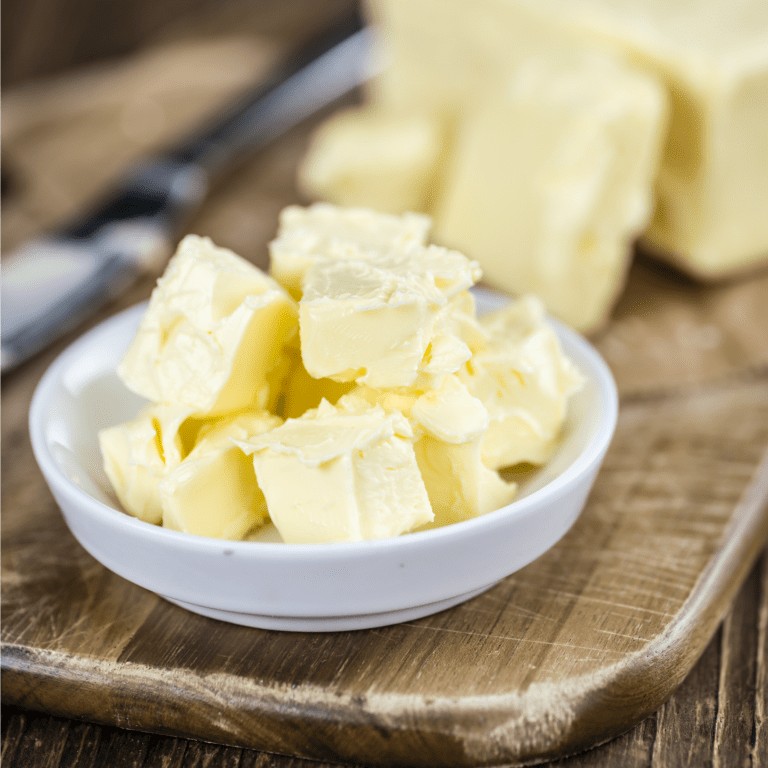Is butter bad for you? With the rapid rise in popularity of the keto diet (and other diets), I thought I’d take a look at some of the health benefits of grass-fed butter. And while it’s important to remember to enjoy butter in moderation, butter isn’t as bad as you may have thought.

Butter is one of those strange foods that tends to fall in and out favor (unless you’re Paula Deen, in which case copious amounts of butter is always in favor).
For centuries, butter has been a dietary staple. In 1902, W.O Atwater, a pioneer nutrition investigator and the first director of the USDA recommended that the majority of people should include butter in their diet.
But in the “fat-free era” and low carb dieting, butter became public enemy number one.
The (incorrect) idea that “fat makes you fat” caused butter to be kicked to the curb in favor of margarine and a variety of “buttery-like spreads”.
I’m a huge proponent of eating real food. I believe that real food is always going to have more health benefits than processed, manufactured food that’s made in a laboratory.
And margarine is anything but a “real food”.
So what exactly is margarine?
Here’s what Free Dictionary has to say:
A fatty solid butter substitute consisting of blend of hydrogenerated vegetable oils mixed with emulsifiers, vitamins, coloring matter and other ingredients.
margarine. (n.d.) American Heritage® Dictionary of the English Language, Fifth Edition. (2011). Retrieved January 4 2023 from https://www.thefreedictionary.com/margarine
What about butter? What are the ingredients in butter?
Take for instance the the ingredient list for Kerrygold pure Irish butter (my favorite, all-natural, grass-fed butter):
- Cultured pasteurized cream
- Salt (Or not! There´s an unsalted version of it!)
Let´s compare these two ingredient lists:
- Cultured pasteurized cream
- Salt (or not)
Margarine:
- Hydrogenated vegetables oils such as soybean, corn, palm, canola or olive oils
- Emulsifiers
- Vitamins
- Coloring matter
- “Other” ingredients
It’s obvious that butter is the clear winner, in terms of what would be considered “real food”.
But there are a number of other (perhaps surprising) health benefits of real, grass-fed butter.
5 Surprising Health Benefits of Grass-Fed Butter

1. Contains heart-healthy omega 3 fatty acids
Omega 3-fatty acids are essential fatty acids. The reason omega-3 fatty acids are called “essential” is because the human body is unable to produce them. Therefore, the only way that our body can get omega-3 fatty acids is through the food we eat.
For optimal health, it’s important that our ratio of omega-6 to omega-3 is less than 4:1. Unfortunately, the average American has a ratio of about 20:1.
Real, grass-fed butter contains an equal ratio of omega-3 fatty acids and omega-6 fatty acids.
(It’s important to note that to maintain equal ratio’s of omega-3 and omega-6 fatty acids, butter must be made from the milk of grass-fed cows, not grain-fed cows.)
2. Lowers pain and inflammation
Grass-fed butter contains both omega-3 fatty acids and conjugated linoleic acid (CLA.)
Both omega-3 fatty acids and CLA have anti-inflammatory properties.
In addition to the anti-inflammatory properties of omega-3 fatty acids and CLA, the high fat content of butter helps to lubricating the joints, which helps to lower joint-related pain.
3. Aids in brain development and helps to keep the brain healthy
Did you know that the human brain is over 60% fat? In fact, the majority of the brain is made of saturated fat and cholesterol.
As such, healthy fats are essential for brain development in infants and children, and play a key role in maintaining brain health in adults.
Because of it’s high levels of saturated fat and cholesterol, butter is considered a brain-healthy food.
4. Contains Activator X
You might be wondering what the heck “activator x” is, and why it’s important.
Basically, you need activator x because it helps your body absorb and use essential minerals. What’s the good in eating foods rich in essential minerals if your body can’t absorb them, right?
Grass-fed butter is an excellent source of activator x, but it MUST be grass-fed butter.
Butter that is produced from the milk of grain-fed cows contains no activator x.
5. Good source of vitamins
Butter contains vitamins A, B12, D, E, and K and most importantly, they’re bioavailable.
What this means is that the vitamins contained in butter are able to be easily absorbed by the body, without having to be converted into a usable form.
How do these vitamins benefit your health?
Vitamin A – crucial for cell growth, a healthy immune system, and healthy eyes and skin.
Vitamin B12 – essential for proper brain and nerve functioning. Many people are deficient in vitamin B12.
Vitamin D – also known as the “sunshine vitamin,” vitamin D helps to support lung function and aids in cardiovascular health, a healthy immune system, and healthy bones, teeth, brain and nervous system.
Vitamin E – helps to protect the body from toxins, neurological diseases and cataracts, and fights against damaging free-radicals.
Vitamin K – prevents excessive bleeding by clotting the blood, and plays a key role in maintaining healthy skin, hair, heart and bones.
Notes on Butter
It’s important to note that despite the many health benefits of grass-fed butter, it should be consumed in moderation.
In the world of healthy fats, butter isn’t the healthiest (avocado and olive oil come out way ahead of butter.)
But there’s no reason to avoid butter entirely, and if you have to choose between butter and margarine, butter is the clear winner.
Remember, try to buy grass-fed butter to ensure maximum nutritional benefits.
My favorite is Kerry Gold Irish Grass-fed butter, which you can find online here.
Hi I’m Ana. I’m all about trying to live the best life you can. This blog is all about working to become physically healthy, mentally healthy and financially free! There lots of DIY tips, personal finance tips and just general tips on how to live the best life.

Leave a Reply